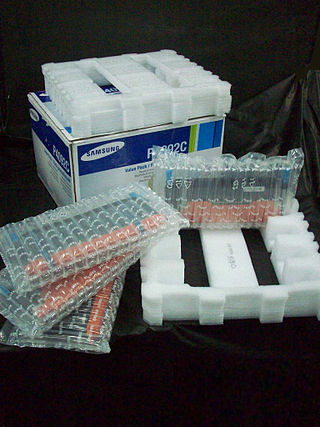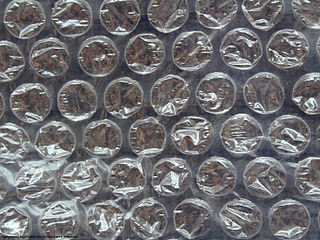
Bubble tea is a tea-based drink that originated in Taiwan in the early 1980s. Taiwanese immigrants brought it to the United States in the 1990s, initially in California through regions including Los Angeles County, but the drink has also spread to other countries where there is a large East Asian diaspora population.

Packaging is the science, art and technology of enclosing or protecting products for distribution, storage, sale, and use. Packaging also refers to the process of designing, evaluating, and producing packages. Packaging can be described as a coordinated system of preparing goods for transport, warehousing, logistics, sale, and end use. Packaging contains, protects, preserves, transports, informs, and sells. In many countries it is fully integrated into government, business, institutional, industrial, and for personal use.

Pop Rocks, also known as popping candy, is a type of candy owned by Zeta Espacial S.A. Pop Rocks ingredients include sugar, lactose, and flavoring. It differs from typical hard candy in that pressurized carbon dioxide gas bubbles are embedded inside of the candy, creating a small popping reaction when it dissolves.

Shrink wrap, also shrink film, is a material made up of polymer plastic film. When heat is applied, it shrinks tightly over whatever it is covering. Heat can be applied with a handheld heat gun, or the product and film can pass through a heat tunnel on a conveyor.

Big League Chew is an American brand of bubble gum made to resemble chewing tobacco. It was created by Portland Mavericks left-handed pitcher Rob Nelson and bat boy and future filmmaker Todd Field. It was then pitched to the Wrigley Company by fellow Maverick and former New York Yankee All-Star Jim Bouton as a healthy imitation of the tobacco-chewing habit common among ballplayers in the 1970s. Big League Chew was introduced in May 1980, in the traditional pink color already seen in established brands of bubble gum. The cartoon-style packaging, originally designed by artist Bill Mayer, comes in colors such as neon green and bright purple (grape). The original shredded R&D concept samples of the product were produced by running standard sheets of bubble gum through an office paper shredder.

SEE, legally the Sealed Air Corporation, is a packaging company known for its brands: Cryovac food packaging and Bubble Wrap cushioning packaging. With over $5.5+ billion in revenues in 2023, it is headquartered in Charlotte, North Carolina, United States, led by Chief Operating Officer Emile Chammas, President, Dustin Semach, and CEO Patrick Kivits.

A heat sealer is a machine used to seal products, packaging, and other thermoplastic materials using heat. This can be with uniform thermoplastic monolayers or with materials having several layers, at least one being thermoplastic. Heat sealing can join two similar materials together or can join dissimilar materials, one of which has a thermoplastic layer.

Sunlight is a brand of laundry soap, laundry detergent and dishwashing detergent manufactured and marketed around the world by Unilever, except in the United States and Canada, where it has been owned by Sun Products since 2010.
Hefty is an American brand of household products such as trash bags and trash cans, disposable tableware, children's disposable tableware, slider closure food storage and freezer bags, plastic storage bins, and disposable cookware. Originally a Mobil product, the brand has been owned by Reynolds Consumer Products since 2010.

Frango mints are a brand of chocolate truffles first created for the Frederick & Nelson department stores. Traditionally flavored with mint and widely popularized by the Marshall Field and Company department store, they were later produced and distributed by Macy's department stores. Frango is also the brand name of a line of various other related food products.

Packaging engineering, also package engineering, packaging technology and packaging science, is a broad topic ranging from design conceptualization to product placement. All steps along the manufacturing process, and more, must be taken into account in the design of the package for any given product. Package engineering is an interdisciplinary field integrating science, engineering, technology and management to protect and identify products for distribution, storage, sale, and use. It encompasses the process of design, evaluation, and production of packages. It is a system integral to the value chain that impacts product quality, user satisfaction, distribution efficiencies, and safety. Package engineering includes industry-specific aspects of industrial engineering, marketing, materials science, industrial design and logistics. Packaging engineers must interact with research and development, manufacturing, marketing, graphic design, regulatory, purchasing, planning and so on. The package must sell and protect the product, while maintaining an efficient, cost-effective process cycle.

Package cushioning is used to protect items during shipment. Vibration and impact shock during shipment and loading/unloading are controlled by cushioning to reduce the chance of product damage.

Nike, Inc. is an American athletic footwear and apparel corporation headquartered near Beaverton, Oregon, United States. It is the world's largest supplier of athletic shoes and apparel and a major manufacturer of sports equipment, with revenue in excess of US$46 billion in its fiscal year 2022.

A padded envelope, also known as a padded or cushioned mailer, or jiffy bag in the United Kingdom, is an envelope incorporating protective padding to protect items during shipping. The padding is usually thick paper, bubble wrap, or foam.

An inflatable air cushion is a bag of fabric or plastic that can be inflated to provide cushioning. Unlike bubble wrap, inflatable air cushions have a check valve to allow the cushion to be inflated or sometimes deflated.

Bubble wrap is a pliable transparent plastic material commonly used for protecting fragile items during shipping. Known for its cushioning air-filled bubbles, it has also become a cultural icon, celebrated for its satisfying popping sound and alternative uses as a stress-relief tool. Regularly spaced, protruding air-filled hemispheres (bubbles) provide cushioning for fragile items.

The Campbell's Company is an American company, most closely associated with its flagship canned soup products. Through mergers and acquisitions, it has grown to become one of the largest processed food companies in the United States with a wide variety of products under its flagship Campbell's brand as well as other brands including Pepperidge Farm, Snyder's of Hanover, V8, and Swanson. With its namesake brand Campbell's produces soups and other canned foods, baked goods, beverages, and snacks. It is headquartered in Camden, New Jersey.

Package testing or packaging testing involves the measurement of a characteristic or property involved with packaging. This includes packaging materials, packaging components, primary packages, shipping containers, and unit loads, as well as the associated processes.
In marketing, a corporate anniversary is a celebration of a firm's continued existence after a particular number of years. The celebration is a media event which can help a firm achieve diverse marketing goals, such as promoting its corporate identity, boosting employee morale, building greater investor confidence, and encouraging sales. As a public relations opportunity, it is a way for a firm to tout past accomplishments while strengthening relationships with employees and customers and investors. The duration of the celebration itself can vary considerably, from an hour or day to activities happening throughout the year. Many businesses use an anniversary to express gratitude for past success. Generally, larger corporations have the means to stage more elaborate celebrations.

Dip & Squeeze is the brand name of a type of packaging for tomato ketchup used by Heinz Tomato Ketchup. The product was announced in 2010 and rolled out to consumers at U.S. fast food restaurants in March 2011. Later in 2011 it was sold directly to retail consumers at Target and Wal-Mart.


















